By Andrew Starnes
Firefighters must continually adapt and improve on their training to face an ever-changing and increasingly complex environment. As their training and skill set has improved, technology has also made significant improvements in the realm of the fire service and the improvement of the delivery of services to the public. Thermal imaging cameras (TICs) have been a part of that technological improvement and service delivery process since the 1990s. This article will provide an overview of thermal imaging use in the fire service along with a glimpse into the not-too-distant future of thermal imaging improvements for firefighters.
A Brief Look at the Past
TICs were introduced to the fire service in the late 1990s. Since then, we have been searching for “the right moment.” Many of these earlier cameras were heavy and expensive. These factors prevented the early models from being readily accessible and feasible for long-term practical application. However, TICs showed strong potential for helping firefighters with many fireground functions.
Over the years, the cost of a TIC has decreased to the point that many departments can afford to purchase multiple cameras. The technology has improved with lower thermal sensitivity and greater resolution quality than ever before. The overall weight and ergonomics of the devices have also improved, making them much easier to use during fire attack and search functions. This was truly our first “taste” of integrating thermal imaging widespread on the fireground.
The Pros and Cons in TIC Development
While the development of major changes or upgrades in fire service thermal imaging seemed to slow, the use of TICs did not. Manufacturers realized that making a product of decent quality was only helpful to the firefighter who was holding the camera. Their answer to this problem: Produce an inexpensive camera so every firefighter can have one! It was at this time that many of our “situational awareness cameras” entered the market.
These TICs went from cameras with 76,800 pixels to 19,200 pixels. The size and weight of the products were reduced compared to prior models as well. Of course, the manufacturers’ intentions in placing more cameras on the fireground to increase overall efficiency were genuine, but the introduction of these newer devices created problems and reduced efficiency.
Pros
- The lower price point of these new devices ensured that most departments supplied every firefighter with a TIC.
- For the first time ever, we witnessed the price of a camera drop to less than $1,000 in some cases.
- Some cameras could fit completely in the palm of a firefighter’s hand.
Cons
- Cameras slowed down from a 30Hz to a 9Hz refresh rate. To put this in perspective, a 9Hz refresh rate is three times slower than human eyes.
- Many firefighters were disappointed when they realized these devices were not close to producing the information their “decision making” counterparts were capable of.
Toward a Current Moment of Situational Awareness Cameras
Since those early years of developmental changes and production, we’ve seen great improvements in image clarity in these devices compared to 30 years ago. In addition to these improvements, we’ve also seen the implementation of the two main types of fire service TICs.
Situational Awareness TICs
Situational awareness cameras have found their place on the market and on the fireground. While the first taste of thermal imaging produced a price point that was too high, many also found the performance was underdeveloped for widespread use and application. Currently, they are great tools for helping firefighters remain oriented, maintain accountability, and locate the general direction of a fire.
Situational awareness TICs were originally designed to prevent firefighter disorientation. The term “situational awareness TIC” was introduced in 2016 by a manufacturer at the same time as the first integrated mask-mounted TIC entered the market. Since then, these models have improved dramatically and now offer tracking capabilities, personnel information (such as air consumption rate and remaining air), and the ability to use these devices to locate other firefighters through unit-to-unit locator capabilities.
Initially, many of these models possessed a 9Hz refresh rate (frames per second) due to export regulations. Now, many of these models range from 16Hz to 30Hz refresh rate. This improvement, along with software enhancements, has allowed for greater situational awareness and less delay in the device relaying information to the firefighter.
Decision-Making TICs
Decision-making TICs are set apart from their situational awareness counterparts in the following areas:
- Insulation/durability.
- Higher resolution (in certain cases).
- Faster refresh rate.
- Larger displays for ease of image interpretation.
These devices have improved greatly from the standard infrared imagers at 320×240 resolution to models consisting of enhanced detectors that offer better image clarity due to the manufacturer’s proprietary software enhancements. In addition to these enhancements, TICs were previously restricted to either dual gain or tri-gain technology. This is where the TIC divides the overall temperature range into two or three spans of more manageable ranges to provide better image clarity.
National Fire Protection Association (NFPA) 1801, Standard on Thermal Imagers for the Fire Service, defines this as high- and low-sensitivity modes. As overall temperatures increase within the TIC’s field of view, the device automatically switches pixel gains from high to low sensitivity, adjusting the image due to the amount of heat within the detector’s field of view. Due to the improvements of software, certain manufacturers offer technology that allows pixel by pixel gain change technology that produces a more fluid display of information without delay and a loss of detail (photo 1).
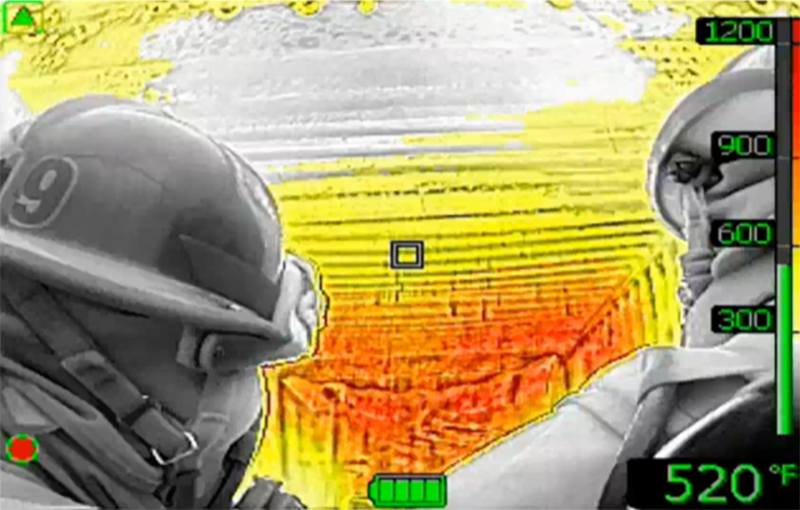
1. A decision-making TIC in action that uses software enhancements. (Photos 1 and 2 courtesy of Insight Fire Training.)
In addition, many manufacturers have improved image clarity within the colorized areas of the image by using proprietary software enhancements that provide greater detail in the uppermost superheated regions of the image that previously would saturate and lose detail.
Outdated Technology Concerns
Despite all these advancements, the fire service seems reluctant to update technology to match the challenges of the modern-day fire environment. According to the U.S. Fire Administration, in 2017 only 70% of the fire departments in the United States had one TIC on the fireground. This study did not state the type or age of that model.
These are concerns within fire departments during the thermal imaging teaching and training process:
- Various brands, models, and ages of TICs are in use at once in one fire department.
- Antiquated devices are still in operation on modern fire apparatus. We have seen thermal imaging devices around 15 to 20 years old still in service on fire apparatus across the United States as shown in photo 2.
- Situational awareness TICs are being used improperly.
- We see many departments purchasing the lower cost options and attempting to use them for size-up and decision making.
To discuss the future of thermal imaging, we must first address the overwhelming issue that many fire departments have not updated their current devices. It’s important to note that fire departments that follow a rotation of replacing their equipment every few years should also follow the same methodology with TICs. To expect older devices to provide up-to-date performance is dangerous and reduces the overall performance of firefighters on the fireground.
The devices in photo 2 are three models produced 20 years ago and are currently being used on front-line fire apparatus today. In addition, many fire departments are not aware of NFPA 1408, Standard for Training Fire Service Personnel in the Operation, Care, Use, and Maintenance of Thermal Imagers, which requires every fire department to provide training on new TICs prior to their being placed in service; to provide annual training on these devices; and specific requirements regarding policies, training requirements, and maintenance.

2. Various brands, models, and ages of TICs in use at once in one fire department.
Industrial Application Features Applied to the Fire Service
While the fire service has not updated its technology overall, industrial thermography has improved dramatically. To exemplify what potential improvements are possible for the fire service, here are a few examples of current modern technological improvements for reference.
Resolution
First, let’s consider the extent to which industrial TICs have improved in resolution vs. firefighting TICs:
- The current level of resolution available to a firefighter is 320×240 resolution (76,800 pixels) or 388×284 (110,192 pixels), which equates to a firefighter’s ability to identify a small child’s hand at 15 to 20 feet.
- A civilian, with no special certifications, can purchase an industrial TIC with 1280×1024 or 1.3 million pixels.
- It is not uncommon to see an industrial thermographer using a 640×480 resolution hand-held thermal imaging detector. To put this into perspective, this is four times the resolution of a fire service TIC at 76,800 pixels, which equates to 307,200 pixels.
- A firefighter equipped with this level of resolution could detect a small child’s hand at approximately 80 feet instead of 15 to 20 feet.
Radiometric vs. JPEG
Industrial TICs store radiometric data. This equates to when an image is captured, each pixel is a stored temperature measurement (within its calibrated range). In a world of litigation and constant scrutiny, infrared data that is stored temperature data is valuable for arson investigation cases and more. Many fire service TICs offer recording capability; however, due to legal reasons, many fire departments choose to restrict this option. The recording of high-resolution infrared data can be extremely valuable in firefighter close call and line-of-duty-death investigations.
There are many amazing application features being used in the industrial world. Certain features could possibly be modified to be used in the firefighting realm. Here are two features that have been used in the past.
Isotherm
An isotherm is where the color palette is programmed to isolate a certain area of interest in one specific color to highlight it for ease of identification (photos 3 and 4).
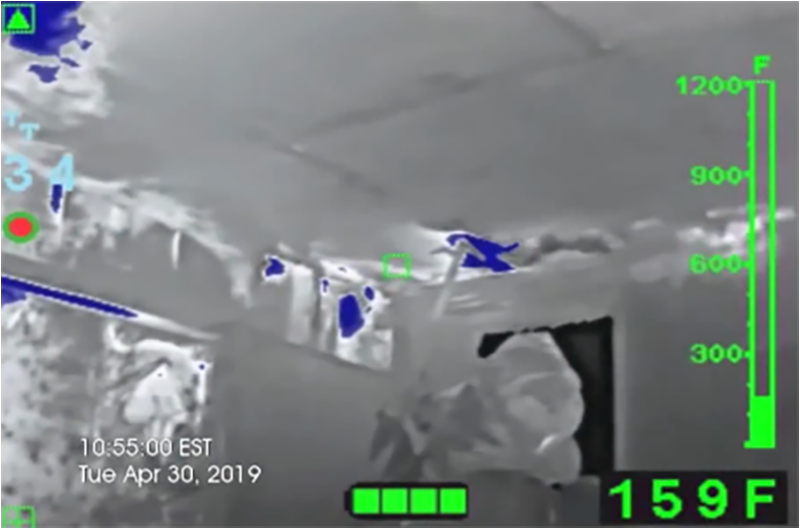
3. An example of isotherm with Bullard’s Electronic Thermal Throttle. (Photo courtesy of Bullard.)

4. An isotherm example and a demonstration of how the software automatically tracks or measures areas of interest. (Photo courtesy of Fire Rover.)
This feature has been around since the 1960s prior to color overlays that are commonly used in many TICs today. This was used to isolate a particular area of interest. Certain manufacturers use this feature as an investigative application mode. It is also commonly used in UAS applications.
Hot Spot and Cold Spot Trackers
These devices have been used for a while and are more commonly known as the box, or area, method, where there is a minimum, maximum, and average temperature tracked. Infrared suppression systems currently use this feature.
The device is equipped with a temperature alarm where the end user sets the device to activate at a preset measurement. Once this alarm is activated, it alerts the operator, who then turns the video and TIC toward the area of alarm and then flows enough foam-water mixture to quickly extinguish the fire.
This is an example of how software and thermal imaging are being used together with an innovative suppression solution. Many older fire service TICs offered a hot spot tracker. The cold spot tracker has been an undervalued feature, as it can quickly locate areas or objects of importance, such as an SCBA cylinder on a firefighter, a victim inside the floor, a hole with a lower temperature behind it, or pathways in heavy content or hoarding environments. As shown in photos 5 and 6, a lost or trapped firefighter’s SCBA cylinder is quickly identified by this feature.
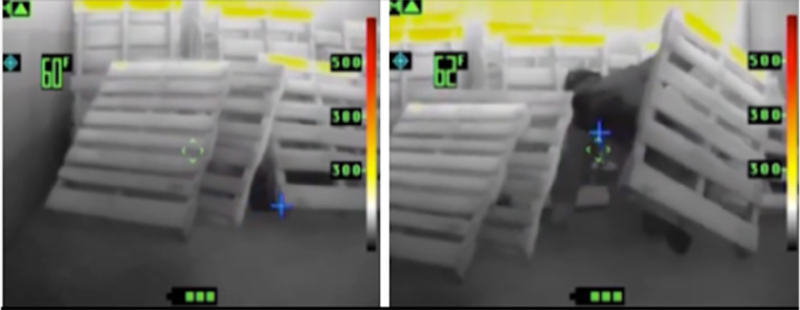
5. A cold spot tracker, an example of how software automatically tracks areas of interest. (Photo courtesy of Scott Safety.)

6. An example of pixel-by-pixel gain change technology. (Photo courtesy of Seek Thermal & Insight Fire Training.)
Thermal Imaging Enhancements
The future of thermal imaging use in the fire service will not be merely infrared technology by itself. Here are four improvements:
- Infrared detector improvements: Newer detector technology with pixel-by-pixel gain change.
- Software enhancements: These will provide real-time usable data without overwhelming the firefighter with too much information.
- Integrated TICs: A combination of an integrated TIC to provide situational awareness, tracking capabilities, and a higher-resolution decision making TIC that provides superior image quality along with investigative features that can be used when needed.
- Edge detection: There are fire service TICs that currently employ edge detection software where the standard infrared image is enhanced by outlining the edges of the objects in the background, providing better image clarity and situational awareness (photos 7 and 8).

7. An older TIC followed by a newer model. (Photo courtesy of Insight Fire Training.)
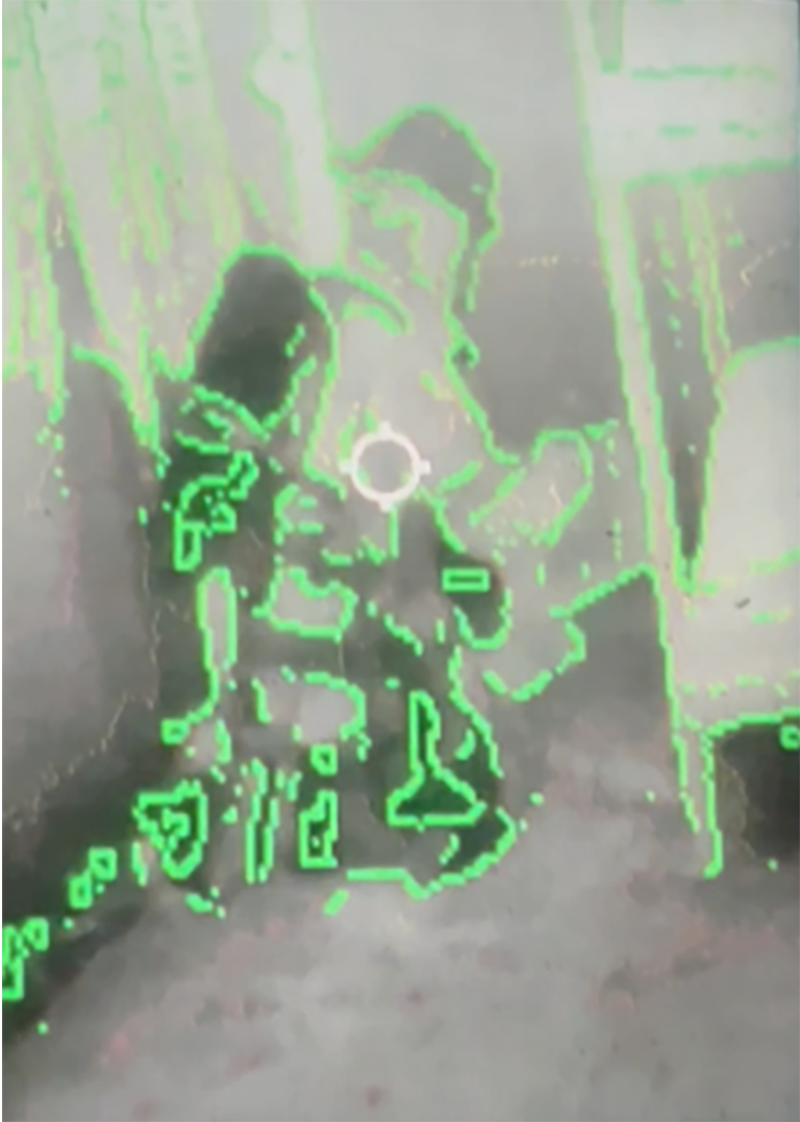
8. An example of edge detection software where the standard infrared image is enhanced by outlining the edges of the objects in the background, providing better image clarity and situational awareness. (Photo courtesy of MSA and Insight Training.)
The Future of Thermal Imaging
With all these advancements currently available, the future of thermal imaging could be overwhelming to the fire service. The future therefore lies in the current users’ understanding and application of current thermal imaging technology. If firefighters become more proficient in their understanding of these valuable devices, then these existing technological benefits can be used in their current service delivery. Thermal imaging usage in the future will involve more than infrared detection itself. For example, there are devices now used in industry that turn sound into images. Consider the possibilities of what this kind of device could do for the future of rescue and locating victims (photo 9).
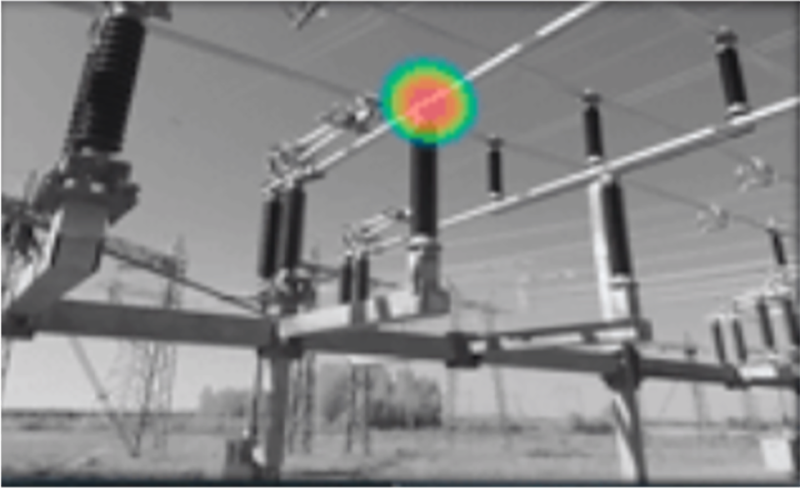
9. An example of an isotherm of a transformer problem identified by a TIC. (Photo courtesy of Teledyne FLIR.)
The future of thermal imaging also includes detecting more than standard long wave infrared (between 7 and 14 micron). There are devices known as optical gas imaging (OGI) cameras that detect leaks of certain gases, whereas fire service TICs do not detect the gases themselves (photo 10).
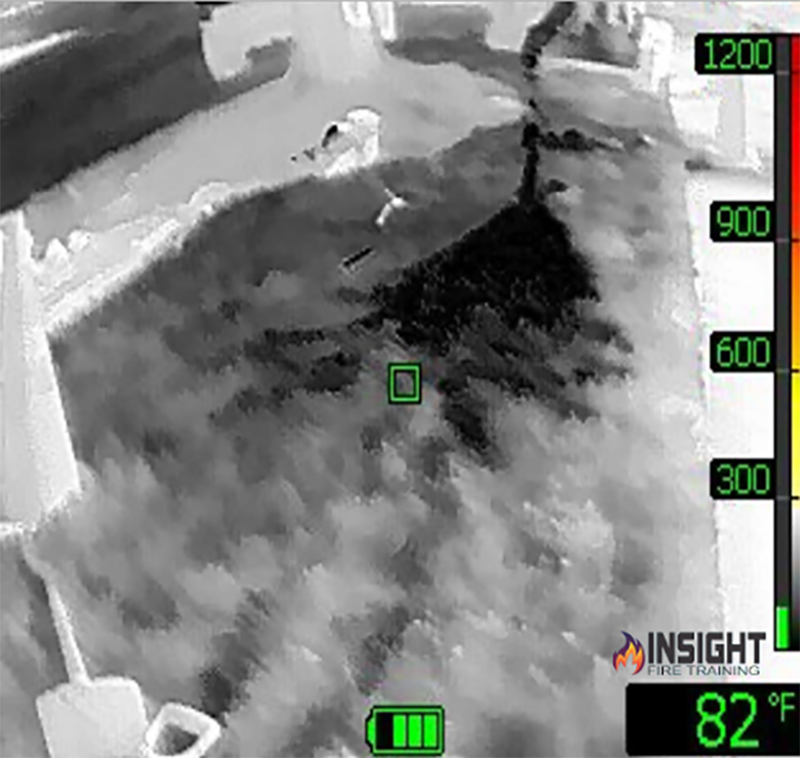
10. A fire service TIC may detect the effects of a gas leak; however, while a TIC identifies where a two-inch gas line underground was cut, it doesn’t detect the vapors or see the vapor cloud itself. (Photo courtesy of Insight Fire Training.)
These OGI cameras were previously very high-cost devices, whereas an uncooled UAS option was produced recently that was dramatically less expensive than its predecessors. Special applications such as USAR and state and federal disaster deployment teams would benefit from these applications.
For search and rescue applications, there now exists software (known as Loc8) that detects anomalies on such a finite level that victims can be located faster than ever before in UAS detector applications. This image scanning software searches for colors (such as a red shirt and blue jeans). At 120 meters, it can detect these minute differences with only four pixels! Another company is developing a system that can track firefighters with one meter accuracy through a helmet-mounted sensor. It includes a biometrics system for monitoring the firefighter’s condition.
With these applications and many more, the future of improved service delivery to our citizens is bright! Incident commanders or first-due officers can locate the fire faster during size-up due to improved resolution and heat location capabilities. Firefighters will be able to locate potential victims faster due to having improved situational awareness. Fire suppression efforts will be more effective and efficient due to the improved ability to locate superheated areas faster in poor visibility.
Where Is Thermal Imaging Headed in the Fire Service?
The future of thermal imaging in the fire service doesn’t stop with the advancement in technology. This is merely the starting point. How will we use this technology to benefit the citizens we protect? Image quality, resolution, and refresh rate are improving every year, but is our overall understanding and implementation of these devices improving along with them?
There will come a time when we no longer have the conversation about why the company officer didn’t have a TIC with him but rather why the firefighter in the room didn’t have his TIC. It’s only a matter of time before this technology is a common part of firefighter PPE. Now we must start having the conversation about how we will use these devices, how we will train on them, and how we can implement their tactical usage on the fireground.
TICs and the Tactical Imagination
In the end, ensuring that well-trained firefighters are equipped with TICs will be highly beneficial. This will allow firefighters to locate victims, locate and extinguish the fire faster, and have improved overall situational awareness. This improved technology can make us more efficient at door control, ventilation, and even reduce property loss in the modern fire environment. Or, it can negatively impact the safety of every firefighter and civilian on the fireground due to our lack of understanding and failure to use TICs appropriately.
We must choose to embrace research and technology, which includes understanding the advantages and disadvantages. Contrary to popular belief, a fire service TIC cannot detect everything or see through objects. The overreliance on these devices with minimal training will create bad habits and inefficient operations every time. The firefighter’s behaviors in scanning technique, communication, and crew positioning will all affect the crew’s overall performance when using a camera.
As the fire service uses TICs, training firefighters on the intricacies of scanning, communicating, and interpreting the information gained from the camera is vital. Imagine crawling down a hallway with two crew members and neither can speak to the other as they search the second-floor bedrooms. They move through rooms in half the time because they know the layout of the room and the furnishings that are there: They see the bunk bed, and they see the crib with the infant in it before their hands ever touch it. Imagine them locating that child and moving that child away from the thermal threat, thereby improving the child’s chance of survival.
Imagine never seeing a firefighter holding onto his partner’s boot again during a search or holding onto a wall or hoseline to stay oriented. Imagine searching buildings in half the time, more efficient hose stretches, and without a loss of fireground accountability. Imagine a more intelligently aggressive fireground. We must ask ourselves: Don’t the citizens deserve every possible chance to survive? If we can improve their chances of survival, extinguish the fire faster, and reduce potential injuries and firefighter deaths, isn’t this technological device worth our consideration?
Author’s note: When this article was written, there was not a 640×480 resolution fire service TIC. There are currently two brands producing this level of resolution.
References
“Needs Assessment of US Fire Service: NFPA.” Nfpa.Org, 2024, bit.ly/4aNdSVS.
“NFPA 1801 Standard Development.” Nfpa.Org, 2021, bit.ly/4e6Iog9.
ANDREW STARNES has been involved with the fire service as a volunteer since 1991 and as a career firefighter since 1988. He is a fire service website contributor on numerous topics and has been featured on podcasts as well as presented tactical thermal imaging courses at numerous conferences. Starnes retired as a battalion chief in 2023 after 25 years of service. He was inducted in the Hall of Legends, Legacies, and Leaders through the National Fire Heritage Center at FDIC 2023.

